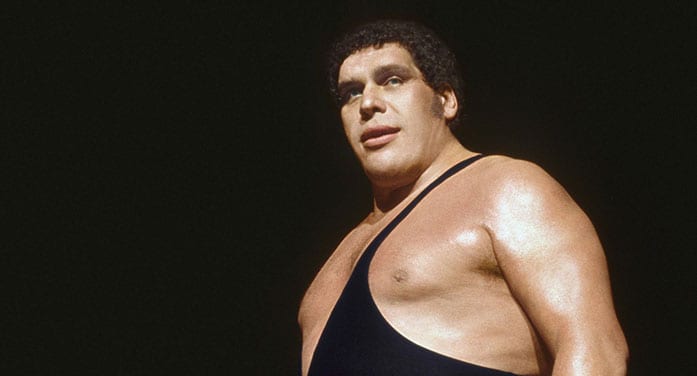 Professional wrestling has had many great performers with athletic prowess and an ability to engage – or, at times, enrage – audiences. Yet one pro wrestler was always in a class of his own: André René Roussimoff, better known as André the Giant.
Professional wrestling has had many great performers with athletic prowess and an ability to engage – or, at times, enrage – audiences. Yet one pro wrestler was always in a class of his own: André René Roussimoff, better known as André the Giant.
Inside the ring, André was a massive, near-invincible foe with seemingly unlimited strength. Outside the ring, he was viewed as a gentle giant and hero to his legions of fans.
In pro wrestling’s carnival-like atmosphere focusing on larger-than-life personalities, the performers’ real identities, successes and struggles are mostly on the record. Since André passed away in 1993, we’ve learned that even a giant’s life can leave the smallest and faintest of footsteps upon its departure.
Bertrand Hébert and Pat Laprade’s magnificent book, The Eighth Wonder of the World: The True Story of André the Giant, helped unlock this Giant mystery. They recognized that André’s “real life and career were the same, clouded by myths and overshadowed by his larger-than-life character and personality.”
Hence, the authors wanted to make sure “the facts were right, the tales were debunked, and, mostly, that someone who didn’t have the chance to see André in person would understand how unique he was.”
| RELATED CONTENT |
| Cody Rhodes has found pro wrestling redemption By Michael Taube |
| Danhausen poised to powerslam pro wrestling By Michael Taube |
| The incredible, emotional and inspirational journey of Thunder Rosa By Michael Taube |
|
|
There was a long-standing myth, for instance, that Irish novelist Samuel Beckett, who kept a house in Molien, France, for “writing retreats,” drove André “back and forth to school in the back of his pickup truck” because he was too big to fit in the village school bus by age 12.
This tale was repeated for decades as fact but was nothing more than fiction. André’s eldest brother, Antoine, said he and his siblings walked a mile and a half to the school in Ussy-sur-Marne “every day, all the time.” His younger brother Jacques also pointed out that Molien didn’t have a school bus until his final academic year – long after his late brother had left.
Maybe Beckett was always waiting for the Giant rather than Godot!
André’s height was often announced at seven feet, four inches, but this couldn’t be confirmed by anyone. Jason Hehir, director of the HBO documentary André the Giant, said that whoever his handler was at a particular time “was just scrawling numbers down on a piece of paper and perpetuating the myth that this guy was anywhere from seven feet to seven feet four and anywhere from 380 to 520 [pounds].”
Then there was his undefeated streak.
Modern fans believed it ended when André was pinned by Hulk Hogan at Wrestlemania III in 1987. That’s incorrect. Although he lost very few matches in his career by either pinfall or submission, wrestling promoters constantly embellished the truth, buried the facts and rewrote the history books.
André lost his first singles match to Peter “Kendo Nagasaki” Thornley on June 7, 1969, during an extensive United Kingdom tour, as well as did Andy Robin, John Lees, Mike Marino and Roy St. Clair. Strong Kobayashi and Thunder Sugiyama and Antonio Inoki either pinned or submitted him in Japan. Ronnie Garvin pinned him in a handicap match in 1978 “on the agreement that the pin … wouldn’t be taped or televised.” The Ultimate Warrior pinned him on several non-televised house shows, too.
Did André care?
No.
Hehir noted in a 2018 Reddit conversation that André was “the primary perpetrator of so much of the mythology. … He seemed to revel in his own mythology and shied away from revealing his own truth.” His mischievous sense of humour was likely part of the reason.
The other reason could have been his personal, private struggles with acromegaly. It made his bones “larger and thicker” and he suffered from “excessive seat, projecting eyebrows, and back problems.” He suffered quietly in pain on flights, buses, cars and in hotels.
The once-athletic giant could barely walk or move in his final years, including his brief run with the WWF world heavyweight title in 1988 (for all of two and a half minutes). He could have had surgery on his pituitary gland to correct this condition but opted against it, according to his friend Jackie McAuley, because “God had made him that way and he wasn’t going to change that.”
In Hébert and Laprade’s view, “André was caring and sensitive, not only with grownups but with children. …People were too easily distracted by André the Giant and very few wanted to know who André Roussimoff was.” Whether he was seen as a wrestling giant or a fun-loving man enjoying a drink and meal with friends, he “imprinted our consciousness, and that turned him into someone unforgettable.”
At long last, the Eighth Wonder of the World is standing tall for the entire world to see.
Michael Taube, a Troy Media syndicated columnist and Washington Times contributor, was a speechwriter for former prime minister Stephen Harper. He holds a master’s degree in comparative politics from the London School of Economics. For interview requests, click here.
The views, opinions and positions expressed by columnists and contributors are the authors’ alone. They do not inherently or expressly reflect the views, opinions and/or positions of our publication.
© Troy Media
Troy Media is an editorial content provider to media outlets and its own hosted community news outlets across Canada.

